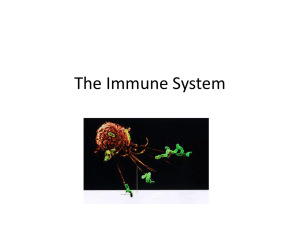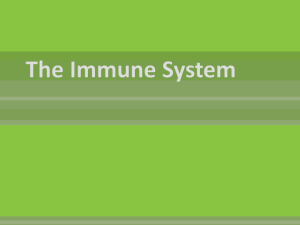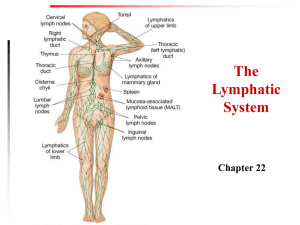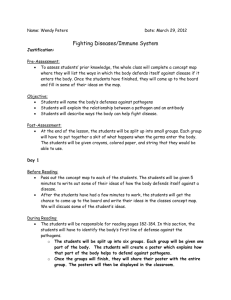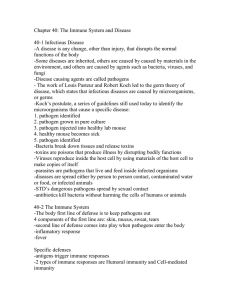Introduction to Host-Microbe Interactions
advertisement
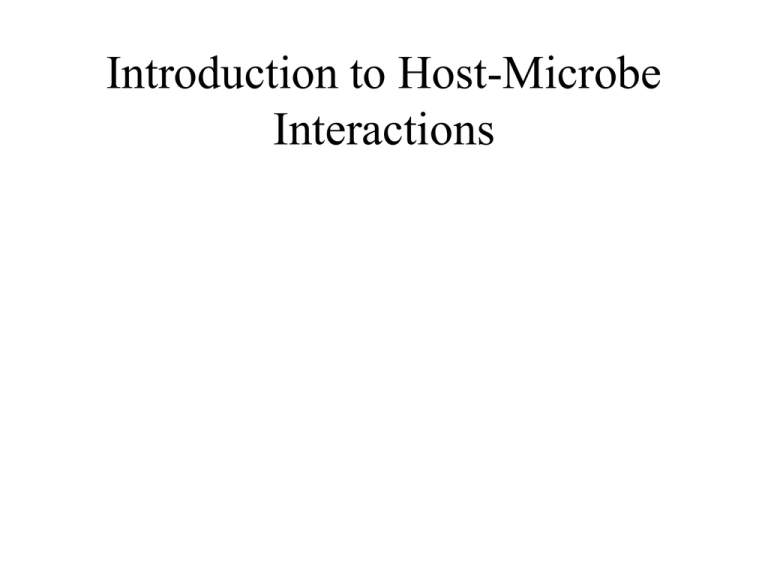
Introduction to Host-Microbe Interactions Normal Flora • More bacterial than human cells in the body – provide some nutrients (vitamin K) – stimulate immune system, immunity can be cross-reactive against certain pathogens – Prevent colonization by potential pathogens (antibiotic-associated colitis, Clostridium difficile) Potential Colonization Sites Types of Pathogens • Primary Pathogens – Cause disease upon infection, not normally associated with host • Plague (Yersinia pestis), influenza virus • Opportunistic Pathogens – Cause disease under some circumstances, sometime members of normal flora • Pseudomonas, Candida albicans Progression of Disease • Transmission: infectious dose from 10-106 organisms • Incubation period: few days (common cold)-weeks (hepatitis A)-months (rabies) • Convalescence: – Clearing (Strep throat, S. pyogenes) – Latency (Chicken pox, tuberculosis, cold sores) Koch’s Postulates • Proposed by Robert Koch • Conclude that a microbe causes a particular disease • Must fulfill four postulates • 1. Microorganism must be present in every case of the disease • 2. Organism must be grown in pure culture from disease hosts • 3. Produce the same disease from the pure culture • 4. Organism recovered from experimentally infected hosts Molecular Postulates • Describe virulence factors • Four postulates • 1. Virulence gene or its product must be present • 2. Virulence gene must transform a nonpathogen into a pathogen • 3. Virulence gene must be expressed during disease process • 4. Antibodies against gene products are protective Establishing an Infection • 1. Encounter: – – – – – fecal-oral (cholera) human-human (tuberculosis) animal-human (rabies) vector-borne (plague, lyme disease) environmental contact (anthrax) Establishing an Infection • 2. Adherence – Prevents early clearance – Often bind host tissues via pili – Specificity can determine host range of pathogen Establishing an Infection • 3. Colonization: multiplication and maintainance – Competition with normal flora – Resist: • • • • • • bile stomach acid peristalsis skin secretions IgA (mucosal antibodies) compete with host for iron Establishing an Infection • 4. Molecule Delivery – Affects target cell structure and host response Invasion:Breaching Anatomical Barriers • Find new niche with few competitors • Gain access to rich nutrient supply • 1. Skin: tough barrier, rely on wounds or insect vectors • 2. Crossing mucous membrane (e.g. intestinal epithelial cells) Zippering-model of invasion Tight ligand-receptor interactions direct uptake “one at a time” uptake Ruffling method of invasion General induced cellular response Can lead to coinvasion of other bacteria in close proximity M cell Invasion • M cells are a portal to the immune system • Important site of “antigen sampling” • Some pathogens use phagocytic nature of M cells to access deeper tissues by transcytosis Avoiding the Host Defenses • 1. Hiding within host cells – Avoid exposure to host antibodies if remain intracellular – Access to rich source of nutrients Cell-to-cell Spreading Shigella and Listeria species lyse out of vacuole -assemble actin at pole -actin propels them into neighboring cell “convergent evolution” “molecular mimicry” Avoiding the Host Defenses • 2. Avoiding complement killing – Complement factors in blood serum can assemble into MAC “membrane attach complex” that are bactericidal – C3b is first component of complex to bind – Some bacteria bind factors that regulate C3b activity, prevent MAC assembly • “serum-resistance” Avoiding the Host Defenses • 3. Avoiding phagocytosis – Innate immune cells engulf (phagocytose) and kill microorganisms with degradative enzymes – Block signaling molecule production or degrade them after production • C5a cleaved by C5a peptidase of Strep pyogenes (strep throat) Avoiding the Host Defenses • 3. Avoiding phagocytosis – Capsule production on surface of bacteria: capsule leads to C3b inactivation-”serum resistance” – M protein of Streptococcus: also inactivates C3b – Fc receptors: bind antibodies and orient dangerous end away from bacteria • Found in Streptococcus (Protein G) and Staphylococcus (Protein A) Survival Strategies within Phagocytes • A niche without competitors • Phagosomal escape: lyse out of vacuole and grow in cytoplasm of host cell – Shigella and Listeria Survival Strategies within Phagocytes • Blocking lysosomal fusion: prevent delivery of degradative enzymes to bacterial compartment – Mycobacterium (tuberculosis) – Salmonella (food poisoning or typhoid fever) – Legionella (Legionnaire’s disease) Survival Strategies within Phagocytes • Surviving lysosomal fusion: – Coxiella – Legionella Avoiding Antibodies • 1. IgA protease: cleaves Ab’s found in mucosal secretions (Neisseria gonorrhoeae) • 2. Antigenic variation: turning pili On and Off, or switching to new pilus • 3. Mimicking the host: look like selfantigens – Streptococcus pyogenes has capsule of hyaluronic acid, also made by host tissues Damage to Host (Disease) • 1. Exotoxins – May require prior colonization (cholera) – May cause food poisoning even in absence of organism • Botulism or Staphylococcus aureus toxin – Immune system often target toxin for neutralizing Ab’s • Vaccine against toxin – A-B toxins: A is catalytic subunit, B binds host cells Damage to Host (Disease) • 2. Membrane-damaging toxins – Hemolysins • Cause cell-lysis: Streptolysin O – Phospholipases • Cleave lipids in membranes: Clostridium perfringens – Gas gangrene Damage to Host (Disease) • 3. Superantigens – Hyperstimulate the immune system • 1/5 T cells stimulated rather than 1/10,000 • Fever, nausea, diarrhea, vomiting – Leads to shock • Organ failure, circulatory collapse – Cause of toxic shock syndrome (TSST) • Staphylococcus aureus and Streptococcus pyogenes Damage to Host (Disease) • 4. Endotoxins (attached to cell) – LPS, in the outer leaflet of Gram negative bacteria • Lipid A is toxic if organisms enter bloodstream – Massive immune cell infiltration – Activation of coagulation • Intravenous fluids are screened for Lipid A Damage due to the Immune System • Inflammation: bacterial meningitis – Neisseria meningitis • Antigen-Ab complexes – Settle in kidney or joints • Glomerulonephritis from S. pyogenes • Cross-reactive Ab’s – Ab’s against pathogen may cross-react with host tissues • Accute rheumatic fever, complication of Strep throat
